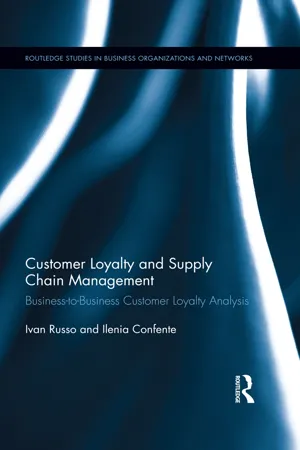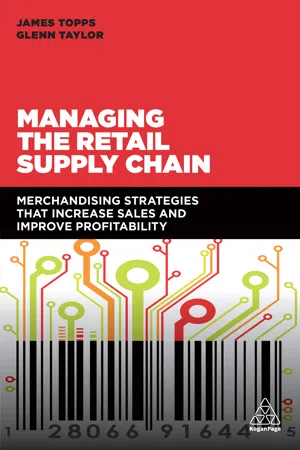Omnichannel Marketing
Omnichannel marketing is a strategy that integrates various marketing channels to provide a seamless and consistent experience for customers across all touchpoints. It focuses on creating a unified brand message and customer journey, allowing individuals to engage with a company through multiple channels such as social media, websites, physical stores, and mobile apps. This approach aims to enhance customer satisfaction and drive better results for businesses.
7 Key excerpts on "Omnichannel Marketing"
- eBook - ePub
Customer Loyalty and Supply Chain Management
Business-to-Business Customer Loyalty Analysis
- Ivan Russo, Ilenia Confente(Authors)
- 2017(Publication Date)
- Routledge(Publisher)
...Channels include brick and mortar retail operations. The term ‘omnichannel’ means to combine in an integrated way different channels, both online and offline, from mobile to brick and mortar and a mix of devices. Customers move freely between in-store, traditional outof-store and online communications as part of a single transaction environment. The omnichannel approach requires companies to redefine their supply strategy and business models. As working separately for each channel can no longer be sustainable, companies that have been traditional brick and mortar are looking to go online while, at the same time, e-tailers are trying various options to establish a physical presence, for example showrooms and pop-up stores, either temporary or permanent. The challenge is to find a seamless solution for both the customer experience and internal processes (Ternstrand, Selldin, Virta, and Linder, 2015). The omnichannel strategy ends the era of online channels that are thought of and treated as a separate channel without integration to the traditional channel. If done properly, a omnichannel experience blurs the distinctions between physical and online interactivity, providing customer with ‘no wall’ stores (Cummins et al., 2016). This happens because, no matter the channel, companies need to respond to the changing marketplace and to meet growing customer demands. In fact, customers want to access at any time and at any place the information about their orders, the delivery status or the level of the stock. Even though they may be in a physical store, they have access to mobile or other devices and they search for information, thus integrating their buying experience...
- eBook - ePub
The Synergy of Business Theory and Practice
Advancing the Practical Application of Scholarly Research
- Alkis Thrassou, Demetris Vrontis, Yaakov Weber, S. M. Riad Shams, Evangelos Tsoukatos(Authors)
- 2019(Publication Date)
- Palgrave Macmillan(Publisher)
...Omni-consumers demand a seamless shopping experience at every interaction or touch point with the company. This could be either during a physical store experience, through e-commerce or m-commerce retail, during home delivery, delivery at store or collection point, or during any other interaction or touch point. Customers want to take advantage of the brick-and-mortar stores, including the ability to try or touch the products, to be assisted by sales consultants, and to live the whole shopping experience; however, they also want all possible product information, such as reviews, tips, competitive prices, which can only be found online. A thriving retail strategy should be a mixture of personalized marketing delivered directly to the customers’ smartphones and proactive marketing based on the customers’ purchase history and data analytics. A personalized customer experience which is at the core of a retailer’s strategy is described as a customer-centric strategy. This procedure of boosting customers’ loyalty and presenting a personalized purchase experience delivered through various physical and online channels positions the customer in the centre of a retailer’s strategy and results in an advantage over their competition (Demko-Rihter and ter Halle 2015). Consequently, marketing plays a vital role in an Omni-channel strategy and must coordinate and integrate between information technologies, information systems, and the supply chain departments of the company...
- eBook - ePub
Marketing Channel Strategy
An Omni-Channel Approach
- Robert W. Palmatier, Eugene Sivadas, Louis W. Stern, Adel I. El-Ansary(Authors)
- 2019(Publication Date)
- Routledge(Publisher)
...Consumers engage in cross-channel shopping by switching among online, mobile, and physical platforms during a single purchase transaction. But in many organizations, the online and in-store experiences may be managed by separate divisions, with differing priorities, so the experience is not really seamless for the customer. Even in the face of well-entrenched cross-channel integration practices, such as when consumers can buy online and pick up products in-store, or else buy online and receive delivery, but then make returns in store, channel integration remains a challenge and a work in progress. An omni-channel system instead harmoniously integrates functions that allow customers to shop— research, purchase, communicate, engage with, and consume the brand —across online, mobile, social, and offline physical channels. In an omni-channel world, channel arrangements help customers move seamlessly and however they choose, across multiple channels during a purchase transaction. 31 As another key distinction, the concept of “consumer engagement” is central to omni-channel approaches; they explicitly seek customer experience and engagement through efforts that rely on social media, email, web links, mobile platforms, store visits, promotional efforts, and so on. In this sense, an omni-channel strategy incorporates various channels of communication, in addition to channels for the physical transfer of goods. 32 Noting these differences, we also highlight several trends that are driving the shift. Trend 1: Channel Participants Operate in a Connected World Nearly 90 percent of Americans are online, more than three-quarters own a smartphone, nearly three-quarters have access to broadband services at home, and 70 percent of consumers use social media. 33 The ubiquity and universality of Internet access have vastly influenced people’s shopping behavior. According to a Google Consumer Barometer report, 52 percent of U.S...
- eBook - ePub
Managing the Retail Supply Chain
Merchandising Strategies that Increase Sales and Improve Profitability
- James Topps, Glenn Taylor(Authors)
- 2018(Publication Date)
- Kogan Page(Publisher)
...08 Omni-channel retailing Omni means all, and the term omni-channel retail reflects the way in which the consumer of today may take several different paths to purchase through any of the retail channels available to them. It could be any of the ever-increasing number of online channels, such as online, mobile, tablet, social media or even virtual reality. The majority of retailers started as bricks and mortar operations, and the skills, capabilities and infrastructure required to seamlessly integrate the retailer’s identity and model throughout the omni-channels isn’t easy. In fact most traditional retailers that haven’t adapted to this landscape are no longer operating. Before we go into the detail of how omni-channel affects supply chain and merchandising it is important to understand some aspects of the omni-channel revolution. Omni-channel customers To deliver and satisfy modern customers, retailers must know them inside out. They must understand the omni-channel customer has powers that were not feasible just a few years ago. An unhappy customer faced with poor service, a difficult returns process, availability issues or any slight inconvenience now has an audience of millions of potential customers. Social media has completely turned the balance of power in favour of the customer. Previously, upsetting a customer may have ended in that customer not shopping with the retailer again and they may have told all their friends and family not to. At worst, a few people might be put off – not such a problem in the old days. Now, customers complain on social media and make sure everyone knows how bad the retailer is that has upset them. However, the technology revolution has also given retailers unprecedented customer information. Retailers know how customers shop, on what device, at what time and what they are searching for. This allows retailers to target the customer, offering them personalized offers based on their shopping trends...
- eBook - ePub
Omni-Channel Retail and the Supply Chain
Working Together for a Competitive Advantage
- Paul Myerson(Author)
- 2020(Publication Date)
- Productivity Press(Publisher)
...people with more information to digest, and new tools and techniques to predict buying patterns and customer needs. Companies today need to tailor their strategies to reach their customers, as a large marketing budget isn’t enough to take advantage of multiple marketing channels. Marketing today is truly omni-channel as companies need to provide a seamless experience, regardless of the channel or device, towards a more personalized, individual communication with consumers, through the various channels and many devices they use. Consumers can now engage with a company in a physical store, on an online website, mobile app, catalog, or via social media using a phone, on their mobile smartphone, a tablet, a laptop, or a desktop computer. It is critical that the consumer’s experience is consistent and complementary. This involves viewing the experience through the eyes of your customer, integrating the customer experience across all channels so that it is seamless, integrated, and consistent, as customers may start in one channel and move to another as they progress to a resolution. The Growth of Digital and Mobile Technology Today, 42 percent of the world’s population are online and 58 percent of all American adults own smartphones. In the United States alone, people now spend more time with digital media (5¼ hours) than viewing traditional TV (4½ hours) each day. Digital and social media marketing uses tools such as websites, social media, mobile ads, apps, online video, email, blogs, etc., to reach consumers via their computers, smartphones, tablets, and other digital devices for promotion, shopping, and assistance (Figure 5.1) [Armstrong and Kotler, 2017]. FIGURE 5.1 E-commerce marketing. Social Media Marketing (SMM) Social media marketing (SMM) involves creating and sharing content on social media applications such as Facebook, Twitter, Google+, LinkedIn, YouTube, Instagram, Pinterest, or other social media sites to reach your planned marketing and branding goals...
- eBook - ePub
- Jochen Strähle, Jochen Strähle(Authors)
- 2015(Publication Date)
- Books on Demand(Publisher)
...Mobile advices enable the consumer to shop location and time independent and his channel choice will be situational driven. It is very likely that the customer uses different channels simultaneously and has higher expectations from the retailer (Schramm-Klein et al., 2014). The traditional observation in which the purchase decision was associated with the channel does not fit anymore to the function and usage of multichannel systems nowadays. The decision process is multi-level and the channels contribute in their combination to the company’s success. That is why the retail environment tries to counteract the changing consumer behavior resulting in increased integration of their sales channels. However, the transition from an isolated multi-channel system to an omni-channel system contains multiple strategic, organizational and corporate cultural challenges (Rittinger, 2014). The multiplicity of the channels and the complexity in controlling the multi-channel-systems will increase, especially because of a growing number of electronic channels. Through increased mobile channel use, the consumer behavior will significantly change and claims for an intensified examination of integration. It is therefore important for the retail industry to focus on the customer. Omni-channeling has the goal to enhance the relationship between consumer and brand. In most cases, an omni-channel retailer can offer his customers added value. However, before implementing such a strategy, the first question must be if multi channeling makes sense for the individual target group. Next step is to identify the buying motivation of the customers, whether they want to safe time, have experience shopping etc.. Resulting recommendations for action can then be derived (Bloching et al., 2013)...
- eBook - ePub
Online Consumer Behavior
Theory and Research in Social Media, Advertising and E-tail
- Angeline Close Scheinbaum, Angeline Close Scheinbaum(Authors)
- 2012(Publication Date)
- Routledge(Publisher)
...11 Exploring Hybrid Channels from the Customer Perspective offering Channels that Meet Customers' Changing Needs Angela Hausman Howard University DOI: 10.4324/9780203123911-11 Marketing channels increasingly take the main stage as organizations realize the impact of channel strategy on meeting customer expectations (Gundlach, Bolumole, Eltantawy, & Frankel, 2006). In addition to managing supply chains for optimal efficiency, this involves creating a desirable mixture of delivery strategies resulting in the ultimate exchange of goods and services at the right price, in the right place, and at the right time. Evidence suggests this mixture must increasingly include both physical and virtual channels (Coelho, Easingwood, & Coelho, 2003) and requires integration between them to meet customer needs (Bendoly, Blocher, Bretthauer, Krishnan, & Vankatraramanan, 2005). Integration forms hybrid channels whereby customers interact seamlessly between virtual and physical supply chains, such as when they purchase products online but pick them up or return them to the physical store. Providing integration between channels can be an important source of value to both organizations and their customers. Evidence of organizational value comes from studies demonstrating that consumers who use multiple channels are a larger group and consume more than single-channel customers (DoubleClick,2004; Kumar & Venkatesan,2005; Pastore,2001). Studies also show integration is critical for retaining customers and creating customer loyalty (Bendoly et al., 2005 ; Kumar & Venkatesan,2005;Reda, 2002). The greater satisfaction reported by customers using hybrid channels also suggests that consumers value them (umar & Venkatesan, 2005)...






